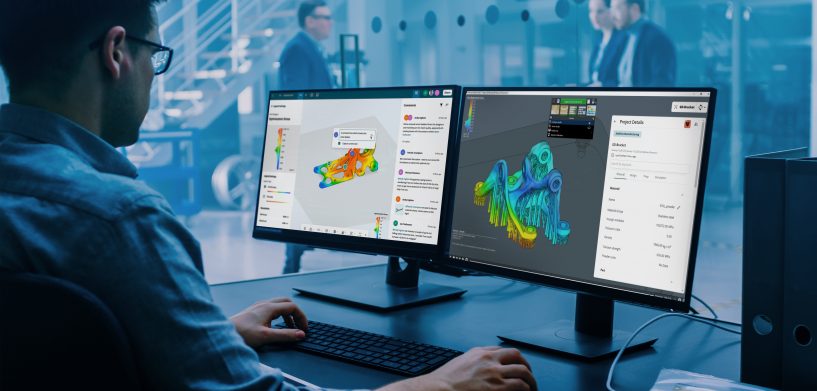As the manufacturing industry navigates a dynamic global market, industry leaders continue to seek innovative solutions to tackle new challenges. During the recent virtual launch of Nexus, experts gathered to share their insights on the current state of manufacturing.
Host
Stephen Chadwick
President, EMEA
Hexagon’s Manufacturing Intelligence Division
Panellists
Ron Bennett
VP, Global IT
Linamar Corporation — an advanced manufacturing company
that specialises in creating motion solutions, including powertrains
for electric vehicles, combine harvesters, and medical devices.
Stan Przybylski
Vice President
CIMdata — a management consulting and research firm
focused exclusively on PLM and digital transformation
Christoph Berlin
GM & Partner Architect
Microsoft Corporation — a multinational technology company
focused on digital transformation
With the launch of Nexus, Hexagon’s new open and flexible digital reality platform, the stage was set for a dynamic exchange on technology’s role in meeting industry demand.
#1 Technology is key to meeting customer expectations
According to Bennett, there is a huge shift in customer expectations in the manufacturing industry. To meet these demands, he highlighted the need for companies to leverage technology to improve accuracy, optimise systems and strengthen collaboration with their supply chain to meet these demands.
#2 Cloud-based technology is essential for global collaboration
With 65 manufacturing sites worldwide, Bennett emphasized the critical role of cloud-based technology in facilitating real-time collaboration. By enabling simultaneous project work without the need to contend with file sharing, data transfer and other technical issues that commonly arise when working across various platforms and systems, cloud-based technology has become an essential tool for enhancing productivity and efficiency in the manufacturing industry.
Przybylski agreed with this sentiment, stating, “Inherently, we still have silos that impede collaboration across different parts of the organisation. Breaking down these silos is crucial to enable collaboration and support better decision-making. That’s where digital twins enabled by a digital thread come in — they provide a vivid realisation of the impact of decisions made across the organisation.”
#3 Another benefit of the cloud: Driving innovation and creating value
Cloud-based technologies are proving to be valuable beyond just collaboration purposes. According to Bennett, cloud-based technology can help companies drive innovation, drive efficiency and create more value for customers. By using advanced, cloud-based analytics tools, businesses can gain access to insights that they might not have been able to see otherwise. This allows them to identify opportunities for optimization and improvement — ultimately reducing costs, improving quality and increasing productivity. In a constantly evolving global market, manufacturers must have access to actionable insights in order to stay competitive. Cloud-based technology is an essential tool that enables this level of access.
#4 Smart data contracts are the key to system integration
Berlin believes that using smart data contracts is the key to integrating multiple applications and systems efficiently. This innovative technology enables the dependency and tracking of one system to another, resulting in a seamless and efficient experience for manufacturers.
According to Berlin, “From a collaboration point of view, it’s about having accessible information from wherever you are and presenting it in the most suitable format for easy consumption.”
#5 Productivity and efficiency: The true goals of technology
As the manufacturing industry evolves, it’s easy to get caught up in the latest buzzwords and trends. But according to Berlin, the true goals of technology adoption are productivity and efficiency. “It’s not just about technology per se anymore,” he explained. ” Rather than focusing on platforms, it’s about having information available and meeting the customer or collaborator wherever they are.”
To illustrate this point, Berlin drew from his own experience. “Let me be very transparent and honest with you — a lot of the developers use Macs because it is their preferred developer platform. Does this mean that we pretty much abandon other systems for Macs?” He emphasised that technology should be thought of in terms of layers and composable architectures, where separate technologies can be integrated to support what is fundamentally important to users. By incorporating different products and systems, a single experience can be created that enhances productivity and brings all aspects of work together.
#6 Managing risks to enable the adoption of new technologies
Innovation and progress often come with risks, and the adoption of new technologies is no exception. Bennett recognizes the importance of managing the risks of adoption so that organisations can take advantage of new systems and platforms that make them more efficient. He highlights the need for a clear vision and effective communication to help engineers understand the value of technology and become more productive and creative in their work. By mitigating risks and embracing change, companies can position themselves for success in an ever-evolving manufacturing landscape.
#7 Nexus is a game-changer for collaboration in engineering
Przybylski and Bennett agreed that the Nexus launch has the potential to revolutionise collaboration in an engineering environment. Przybylski noted that the platform’s democratisation of simulation capabilities makes it a game-changer, while Bennett said “As an engineer entering a Nexus-type platform or system, it’s like being a kid in a candy store. You gain access to things you may have never had access to before.”
Berlin also added, “Nexus is paving the way for a new era of collaboration and efficiency in the manufacturing industry. It’s not just about the technology or platform. It’s about meeting the customer and working better together in a world where we often don’t sit in the same office any longer.”
The future of manufacturing belongs to those who are willing to take risks, experiment and adapt to changing times. With the launch of Nexus, industry leaders are at the forefront of this revolution, using innovative tools to seamlessly integrate systems and democratise simulation capabilities. By embracing these innovative technologies, manufacturers can not only meet the challenges of the current market but also unlock new opportunities for growth, efficiency and innovation.
[Miss the virtual launch? You can view the entire event recording here!]





















